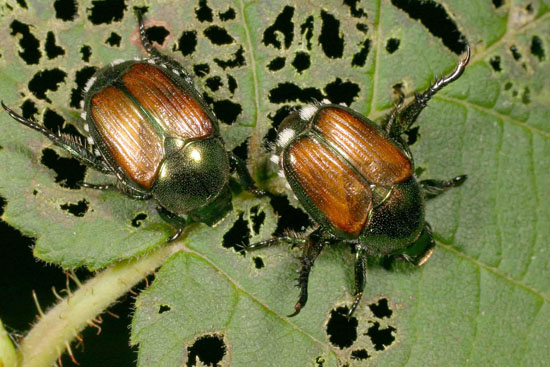Issue 8, June 12, 2009
Japanese Beetle
Japanese beetle adults were picked up in a trap in Massac County on June 7 by Ron Hines of Growmark. Based on that, we are expecting adults to emerge in central Illinois by about June 21 and around July 5 in northern Illinois.
In central and northern Illinois, it is likely that numbers will be reduced to about one-third of those of last year. The reason for this is that most Japanese beetle grubs only migrate about eleven inches deep to spend the winter, and they can only tolerate freezing temperatures for about three weeks. Last winter, the ground froze to about 18 inches deep in central Illinois and stayed that way for about five weeks. In northern Illinois, the soil froze about two feet deep in most areas and remained frozen for six to eight weeks.
Based on the high numbers experienced in southern Illinois last year, we are expecting numbers to be high again this year. The other major mortality factor for Japanese beetle in Illinois besides frozen soil is dry soil during the summer and fall because eggs and young larvae are more vulnerable to those conditions. Because there were no droughts in Illinois last year and the soil did not freeze deeply in southern Illinois, we are expecting high numbers there.
Japanese beetle adults are three-eighths to one-half inch long stocky beetles. They are metallic green with coppery wing covers. There is a row of white spots on the side of the abdomen just below the wing covers and two more white spots on the posterior end of the abdomen. These white spots consist of patches of white hairs.

The adults emerge from pupae in turf areas where the larval white grubs fed on the turf roots late last summer into fall and then again this spring. Males emerge first and hang out on the turf waiting for females to emerge from the soil. Emerging females are immediately attacked by large numbers of males trying to mate with her. Enough males will try this that they form a ball of male beetles with a female in the center. These balls of beetles are about the size of a ping pong ball and the process is called "balling." This occurs for several days until most of the females have emerged. Females and males then fly from the turf to adult feeding plants.
Adult Japanese beetles feed on a variety of trees and shrubs, being most common on linden, birch, willow, crabapple, and rose. Probably their favorite adult feeding plant is smartweed, and many scout that plant to detect the first beetle emergences. The beetles will be most numerous on the upper, sunlit leaves of the plant, eating through the upper leaf epidermis and eating the mesophyll. The lower epidermis is left intact, causing attacked leaves to initially appear whitish. These leaves turn brown as the exposed epidermal cells die. The beetles also eat holes through the leaves.
Japanese beetles switch hosts every three days, flying as much as a mile and a half to a new host. They are attracted to leaves and blossoms that have already been fed upon by Japanese beetles. They feed on plants in this way for about six weeks.
Handpicking every other day or so is an effective control method for homeowners and others. A wide-mouthed jar, such as a peanut butter jar, with an inch or two of rubbing alcohol or soapy water makes an effective collector. Hold the jar under the beetle and poke at the beetle. In the afternoon and evening, the Japanese beetle will fold its legs and drop off of the leaf into the jar where it will be killed. In the morning or early afternoon, disturbed beetles tend to fly up into your face.
Insecticide sprays are also effective against Japanese beetle adults. Spray the foliage of attacked plants with carbaryl (Sevin) or cyfluthrin (Tempo, Bayer Advanced Multiinsect Killer), permethrin (Astro, Eight Insect Spray), or other labeled pyrethroid every two weeks for the six weeks that feeding damage is heavy.
If you are limited to only one spray or handpicking for only a week or so, it is better to do this soon after the beetles emerge and fly to host plants. Because the beetles fly to previously attacked plants when changing hosts, preventing early feeding damage will usually result in less damage through the season even if pest control efforts are limited.--Phil Nixon
Author:
Phil Nixon